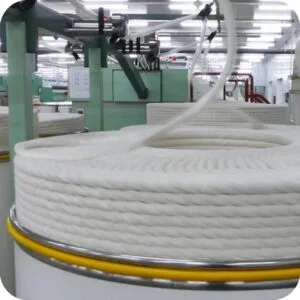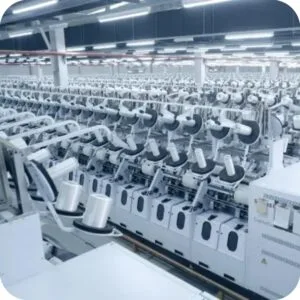
Ladies and gentlemen, gather around! Today, we’re diving into a topic that has been spinning heads (literally) in the fabric world: the difference between #twisted and #non-twisted fabrics. If you thought the fabric industry was all about smooth, silky materials and colorful patterns, well, buckle up! We’re going to unravel some twists, untangle some yarns, and throw a little humor into the mix.
Before we start spinning stories, let’s get a few things straight. The “twist” in #twisted fabrics refers to the process of twisting fibers (like cotton, polyester, or wool) into yarns. Think of it like curling your hair, but in fabric form. The twist adds texture, durability, and often, a bit of pizzazz. On the flip side, #non-twisted fabrics are like that lazy Sunday morning when you roll out of bed and don’t even bother to run a comb through your hair. It’s a smoother, simpler take on fabric creation—no twists, no frills, just pure, unadulterated softness or structure.
The Spinning Process: How Do You Get Twisted?
So how exactly does fabric get its twist on? Well, the #twisted yarn is created by spinning two or more fibers together in a spiral, usually in a clockwise or counterclockwise direction (yep, there’s a choice). The more twists you add, the stronger the yarn. But wait—there’s a catch. Over-twisting can cause the yarn to break down and lose its strength. So, much like a good dance move, it’s all about finding the right rhythm and balance.
On the other hand, #non-twisted fabrics are made by spinning the fibers into a simple straight line, often using a less intense process. It’s almost like not bothering with all those crazy dance moves at a wedding and just sticking to the two-step. Sometimes, simple is just as elegant.
The Pros of Twisted Fabrics: Strength, Durability, and Personality!
Now that we understand the basics of twisting, let’s talk about the #pros of #twisted fabrics. What do you get when you add a little spin to your fabric? Let’s break it down:
1.Durability – Just like a well-constructed bicycle tire, #twisted fabrics are built to withstand the test of time (and wear). The twisting process strengthens the fibers, making the fabric less likely to tear, stretch, or lose shape. If you’re in the market for something durable, twisted fabrics are your sturdy, reliable friend. They’re the superhero of the fabric world—without the cape (unless we’re talking about velvet, but that’s a different story).
2.Texture and Appearance – Ever looked at a fabric and thought, “Now that’s got some character”? Well, that’s the magic of twisting. Twisted fibers can create a unique texture—whether it’s a slightly rough surface, a subtle sheen, or even a bouncy, springy quality. Twisted fabrics like #twill, #jacquard, and #satin have a bit of a “wow” factor, making them ideal for high-end fashion or those bold design choices. They’re like the fabric equivalent of the friend who always shows up to the party with a funky hat.
3.Strength for Heavy-Duty Uses – Need something tough enough to handle the pressures of industrial use or heavy-duty tasks? Twisted fabrics win here, too. They’re perfect for things like #workwear, outdoor gear, and #automotive applications. Think of them as the #Hulk of the textile world—tough and reliable, but with a stylish edge.
4.Versatility in Design – The beauty of twisted fabrics lies in their adaptability. You can twist them in different ways to create various patterns, such as #heathered looks, stripes, and other interesting textures. This flexibility allows twisted fabrics to stand out in both casual and formal settings. Whether you’re designing #fashionable apparel or creating #upholstery materials, twisted fabrics offer endless possibilities.
The Cozy Comfort of Non-Twisted Fabrics
Alright, alright. We’ve sung the praises of twisted fabrics, but don’t go thinking that #non-twisted fabrics are just sitting around twiddling their thumbs. Non-twisted fabrics may not have the same textural complexity, but they offer a different kind of magic. Let’s take a look at their advantages:
1.Softness and Comfort – Sometimes, the best things in life are the simplest, and that’s certainly true for #non-twisted fabrics. The lack of twist means the fibers remain more relaxed, which often results in a softer, smoother fabric. If you’re thinking #bedding, #sheets, or the coziest pair of pajamas, non-twisted fabrics are your best bet for pure, unadulterated comfort. They’re like a warm hug after a long day.
2.Breathability – Without the added tension from twisting, non-twisted fabrics tend to have more air pockets between the fibers, which makes them more breathable. This is why they are frequently used for #activewear, #underwear, and #sportswear. They let your skin breathe, even if you’re running a marathon or just tackling a gym workout (or, let’s be honest, just walking to the fridge).
3.Smooth, Sleek Appearance – Non-twisted fabrics have a smooth finish that can look elegant and sophisticated without much effort. Think of the sleek lines of #satin or the smooth flow of #viscose fabrics. These fabrics are all about understated elegance and sophistication—perfect for your next #party dress or #eveningwear ensemble.
4.Cost-Effectiveness – Generally speaking, non-twisted fabrics can be more affordable than twisted fabrics. If you’re on a tight budget but still want something that looks good and feels great, non-twisted fabrics are your best friend. They deliver quality without the extra cost of added twists.
When Should You Twist? When Should You Not?
Now that we know the pros and cons of both twisted and non-twisted-fabrics, you may be wondering, “When should I use each one?” Well, lucky for you, we’ve got some guidelines.
•For strength and durability – Twisted-fabrics are ideal for products that need to stand the test of time. Think of items that go through a lot of wear and tear, like #outdoorgear, #bags, #workwear, and #upholstery.
•For texture and aesthetics – Need a little flair in your design? Twisted-fabrics like #jacquard or #twill offer texture and depth that non-twisted fabrics simply can’t match. Use them for bold #fashion or high-end #interior design projects.
•For heavy-duty applications – Twisted-fabrics are made to last, so they’re great for anything that requires structural integrity, like #automotive upholstery or #industrial applications.
When to Skip the Twist:
•For softness and comfort – Non-twisted-fabrics reign supreme when it comes to comfort. If you’re designing anything related to #sleepwear, #bedlinen, or #babyclothes, non-twisted-fabrics like #cotton and #viscose will keep things cozy.
•For breathability and lightness – If you need something that breathes, like for #activewear or #sportswear, non-twisted fabrics are your go-to choice.
•For smooth, sleek elegance – For those times when you need a smooth, sleek finish without the heavy texture, non-twisted fabrics like #satin or #silk can deliver that effortlessly chic look.
Conclusion: Twist or No Twist? That Is the Question!
So, are you team #twisted or team #non-twisted? The answer depends on your needs! Twisted fabrics offer durability, texture, and versatility, while non-twisted fabrics give you comfort, softness, and breathability. Both have their place in the fabric world, and knowing when to use each can make all the difference in your design or product.
At the end of the day, whether you’re creating #fashionable clothes, durable #outdoorgear, or comfortable #bedlinen, there’s a fabric out there that fits your exact needs. So next time you’re shopping for fabrics, remember: it’s all about the twist—or the lack thereof. And as always, have fun with it!
#FreeWaterproofFabric #PUCoatingFabric #JacquardFashionFabric #MilkyPUCoating #fabrics #cloth #textile #Cotton #Recycled #Nylon #Polyester #Jacquard #Printing #PUMilky #Oxford



